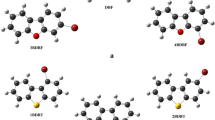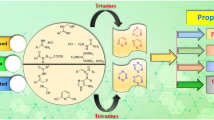Abstract
Synthesis of novel 3,6-di(substituted quinoxalin) carbazole fluorophores by the condensation of 1,1′-(9-ethyl-9H-carbazole-3,6-diyl)bis(2-bromoethanone) with methyl, chloro and unsubstituted o-phenylenediamine is presented. Synthesized derivatives are well characterized by 1H NMR, 13C NMR, FTIR and Mass spectroscopy. Photophysical studies are carried out using solvents of varying polarities revealed positive solvatochromism and intramolecular charge transfer from carbazole (Donor) to quinoxalin (Acceptor). Intramolecular charge transfer properties are correlated by dipole moment changes and different polarity functions like Lippert–Mataga, Bilot-Kawski, Bakhshiev and Liptay plots with very good regression factors. Mulliken hush-analysis further support charge transfer characteristic. Linear and Nonlinear optical properties are explained by solvatochromic data using two-level quantum mechanical model and are correlated with computational calculations using density functional theory at B3LYP/6-31G(d) level. First hyperpolarizability value of all the synthesized compounds is found to be greater than urea by >333 times. Moreover, increase of hyperpolarizability values from non-polar to polar solvents are in good correlation with the significant charge transfer characteristic in polar solvents.


Similar content being viewed by others
References
Loudet A, Burgess K (2007) BODIPY dyes and their derivatives: syntheses and spectroscopic properties. Chem Rev 107:4891–4932. doi:10.1021/cr078381n
Zheng K, Lin W, Tan L et al (2014) A unique carbazole–coumarin fused two-photon platform: development of a robust two-photon fluorescent probe for imaging carbon monoxide in living tissues. Chem Sci 5:3439. doi:10.1039/C4SC00283K
Sekar N, Umape PG, Lanke SK (2014) Synthesis of novel Carbazole fused Coumarin derivatives and DFT approach to study their Photophysical properties. J Fluoresc 24:1503–1518. doi:10.1007/s10895-014-1436-6
Singh P, Baheti A, Thomas KRJ (2011) Synthesis and optical properties of Acidochromic amine-substituted benzo[ a ]phenazines. J Org Chem 76:6134–6145. doi:10.1021/jo200857p
Zheng ML, Fujita K, Chen WQ et al (2011) Comparison of staining selectivity for subcellular structures by carbazole-based cyanine probes in nonlinear optical microscopy. Chembiochem 12:52–55. doi:10.1002/cbic.201000593
Joule JA (1984) Recent advances in the chemistry of 9H-carbazoles. Adv Heterocycl Chem. Elsevier, pp 83–198
Morin J-F, Leclerc M (2001) Syntheses of conjugated polymers derived from N-alkyl-2,7-carbazoles. Macromolecules 34:4680–4682. doi:10.1021/ma010152u
Yoon KR, Ko S-O, Lee SM, Lee H (2007) Synthesis and characterization of carbazole derived nonlinear optical dyes. Dyes Pigments 75:567–573. doi:10.1016/j.dyepig.2006.07.004
Tsai J-H, Chueh C-C, Lai M-H et al (2009) Synthesis of new Indolocarbazole-acceptor alternating conjugated copolymers and their applications to thin film transistors and photovoltaic cells. Macromolecules 42:1897–1905. doi:10.1021/ma802720n
Ning Z, Fu Y, Tian H (2010) Improvement of dye-sensitized solar cells: what we know and what we need to know. Energy Environ Sci 3:1170. doi:10.1039/c003841e
Brunner K, van Dijken A, Börner H et al (2004) Carbazole compounds as host materials for triplet emitters in organic light-emitting diodes: tuning the HOMO level without influencing the triplet energy in small molecules. J Am Chem Soc 126:6035–6042. doi:10.1021/ja049883a
Zhang D, Martín V, García-Moreno I et al (2011) Development of excellent long-wavelength BODIPY laser dyes with a strategy that combines extending π-conjugation and tuning ICT effect. Phys Chem Chem Phys 13:13026. doi:10.1039/c1cp21038f
Zhao YS, Fu H, Peng A et al (2008) Low-dimensional nanomaterials based on small organic molecules: Preparation and optoelectronic properties. Adv Mater 20:2859–2876. doi:10.1002/adma.200800604
Law KY (1993) Organic photoconductive materials: recent trends and developments. Chem Rev 93:449–486. doi:10.1021/cr00017a020
Haidekker MA, Brady TP, Lichlyter D, Theodorakis EA (2006) A ratiometric fluorescent viscosity sensor. J Am Chem Soc 128:398–399. doi:10.1021/ja056370a
Li Z, Dong YQ, Lam JWY et al (2009) Functionalized Siloles: versatile synthesis, aggregation-induced emission, and sensory and device applications. Adv Funct Mater 19:905–917. doi:10.1002/adfm.200801278
Jadhav AG, Shinde SS, Lanke SK, Sekar N (2017) Benzophenone based fluorophore for selective detection of Sn2+ ion: experimental and theoretical study. Spectrochim Acta Part A Mol Biomol Spectrosc 174:291–296. doi:10.1016/j.saa.2016.11.051
Jadhav AG, Kothavale S, Sekar N (2017) Red emitting triphenylamine based rhodamine analogous with enhanced Stokes shift and viscosity sensitive emission. Dyes Pigments 138:56–67. doi:10.1016/j.dyepig.2016.11.021
Yang Z, Zhao N, Sun Y et al (2012) Highly selective red- and green-emitting two-photon fluorescent probes for cysteine detection and their bio-imaging in living cells. Chem Commun (Camb) 48:3442–3444. doi:10.1039/c2cc00093h
Devaraj NK, Hilderbrand S, Upadhyay R et al (2010) Bioorthogonal turn-on probes for imaging small molecules inside living cells. Angew Chem Int Ed 49:2869–2872. doi:10.1002/anie.200906120
Huang TH, Whang WT, Shen JY et al (2006) Dibenzothiophene/oxide and quinoxaline/pyrazine derivatives serving as electron-transport materials. Adv Funct Mater 16:1449–1456. doi:10.1002/adfm.200500823
Son H, Han W, Yoo D et al (2009) Fluorescence control on panchromatic spectra via C-alkylation on Arylated Quinoxalines. J Org Chem 74:3175–3178
Son HJ, Han WS, Wee KR et al (2008) Turning on fluorescent emission from C-alkylation on quinoxaline derivatives. Org Lett 10:5401–5404. doi:10.1021/ol802287k
Zhao ZH, Jin H, Zhang YX et al (2011) Synthesis and properties of dendritic emitters with a fluorinated starburst oxadiazole core and twisted carbazole dendrons. Macromolecules 44:1405–1413. doi:10.1021/ma1024957
Qi T, Liu Y, Qiu W et al (2008) Synthesis and properties of fluorene or carbazole-based and dicyanovinyl-capped n-type organic semiconductors. J Mater Chem 18:1131. doi:10.1039/b715920j
Zhang X, Shim JW, Tiwari SP et al (2011) Dithienopyrrole–quinoxaline/pyridopyrazine donor–acceptor polymers: synthesis and electrochemical, optical, charge-transport, and photovoltaic properties. J Mater Chem 21:4971. doi:10.1039/c0jm04290k
Paley MS, Harris JM, Looser H et al (1989) A solvatochromic method for determining second-order polarizabilities of organic molecules. J Org Chem 54:3774–3778. doi:10.1021/jo00277a007
Chen L, Cui Y, Mei X et al (2007) Synthesis and characterization of triphenylamino-substituted chromophores for nonlinear optical applications. Dyes Pigments 72:293–298. doi:10.1016/j.dyepig.2005.09.008
Wang Y, Frattarelli DL, Facchetti A et al (2008) Twisted π-electron system electrooptic chromophores. Structural and electronic consequences of relaxing twist-inducing nonbonded repulsions. J Phys Chem C 112:8005–8015. doi:10.1021/jp8003135
Momicchioli F, Ponterini G, Vanossi D (2008) First- and second-order polarizabilities of simple merocyanines. An experimental and theoretical reassessment of the two-level model J Phys Chem A 112:11861–11872. doi: 10.1021/jp8080854
Qian Y (2008) 3,6-Disubstituted carbazole chromophores containing thiazole and benzothiazole units: synthesis, characterization and first-order hyperpolarizabilities. Dyes Pigments 76:277–281. doi:10.1016/j.dyepig.2006.08.040
Huyskens FL, Huyskens PL, Persoons AP (1998) Solvent dependence of the first hyperpolarizability of p-nitroanilines: differences between nonspecific dipole-dipole interactions and solute-solvent H-bonds. J Chem Phys 108:8161–8171. doi:10.1063/1.476171
Frisch MJ, Trucks GW, Schlegel HB, et al. (2009) Gaussian 09, revision C.01. Gaussian 09, Revis. B.01, Gaussian, Inc., Wallingford CT
Thomas KRJ, Tyagi P (2010) Synthesis, spectra, and theoretical investigations of the Triarylamines based on 6 H -Indolo[2,3- b ]quinoxaline. J Org Chem 75:8100–8111. doi:10.1021/jo1016663
Treutler O, Ahlrichs R (1995) Efficient molecular numerical integration schemes. J Chem Phys 102:346. doi:10.1063/1.469408
Becke AD (1993) A new mixing of Hartree–Fock and local density-functional theories. J Chem Phys 98:1372. doi:10.1063/1.464304
Lee C, Yang W, Parr RG (1988) Development of the Colle-Salvetti correlation-energy formula into a functional of the electron density. Phys Rev B 37:785–789. doi:10.1103/PhysRevB.37.785
Casida ME, Jamorski C, Casida KC, Salahub DR (1998) Molecular excitation energies to high-lying bound states from time-dependent density-functional response theory: characterization and correction of the time-dependent local density approximation ionization threshold. J Chem Phys 108:4439. doi:10.1063/1.475855
Cossi M, Barone V, Cammi R, Tomasi J (1996) Ab initio study of solvated molecules: a new implementation of the polarizable continuum model. Chem Phys Lett 255:327–335. doi:10.1016/0009-2614(96)00349-1
Tomasi J, Mennucci B, Cammi R (2005) Quantum mechanical continuum solvation models. Chem Rev 105:2999–3093. doi:10.1021/cr9904009
Patil VS, Padalkar VS, Sekar N (2014) 2-methyl-4-oxo-N-(4-oxo-2-phenyl substituted-1,3-thiazolidin-3-yl)-3,4- dihydroquinazoline-5-carboxamides - a new range of fluorescent whiteners: synthesis and photophysical characterization. J Fluoresc 24:1077–1086. doi:10.1007/s10895-014-1387-y
Williams ATR, Winfield SA, Miller JN (1983) Relative fluorescence quantum yields using a computer-controlled luminescence spectrometer. Analyst 108:1067. doi:10.1039/an9830801067
Telore RD, Satam MA, Sekar N (2015) Push-pull fluorophores with viscosity dependent and aggregation induced emissions insensitive to polarity. Dyes Pigments 122:359–367. doi:10.1016/j.dyepig.2015.07.017
Chen Y, Ling Y, Ding L et al (2016) Quinoxaline-based cross-conjugated luminophores: charge transfer, piezofluorochromic, and sensing properties. J Mater Chem C 4:8496–8505. doi:10.1039/C6TC02945K
Stock LM (1972) The origin of the inductive effect. J Chem Educ 49:400. doi:10.1021/ed049p400
Kerber RC (2006) If It’s resonance, what is resonating? J Chem Educ 83:223. doi:10.1021/ed083p223
Carlotti B, Flamini R, Kikaš I et al (2012) Intramolecular charge transfer, solvatochromism and hyperpolarizability of compounds bearing ethenylene or ethynylene bridges. Chem Phys 407:9–19. doi:10.1016/j.chemphys.2012.08.006
Oudar JL (1977) Optical nonlinearities of conjugated molecules. Stilbene derivatives and highly polar aromatic compounds. J Chem Phys 67:446. doi:10.1063/1.434888
Oudar JL, Zyss J (1982) Structural dependence of nonlinear-optical properties of methyl-(2,4-dinitrophenyl)-aminopropanoate crystals. Phys Rev A 26:2016–2027. doi:10.1103/PhysRevA.26.2016
Kwon OP, Jazbinsek M, Seo JI et al (2010) First hyperpolarizability orientation in asymmetric pyrrole-based polyene chromophores. Dyes Pigments 85:162–170. doi:10.1016/j.dyepig.2009.10.019
Mardar SR, Beratan DN, Cheng L-T (1991) Approaches for optimizing the first electronic hyperpolarizability of conjugated organic molecules. Science 80(252):103–106. doi:10.1126/science.252.5002.103
Cheng LT, Tam W, Stevenson SH et al (1991) Experimental investigations of organic molecular nonlinear optical polarizabilities. 1. Methods and results on benzene and stilbene derivatives. J Phys Chem 95:10631–10643. doi:10.1021/j100179a026
Dirk CW, Cheng L-T, Kuzyk MG (1992) A simplified three-level model describing the molecular third-order nonlinear optical susceptibility. Int J Quantum Chem 43:27–36. doi:10.1002/qua.560430106
Kuzyk MG, Dirk CW (1990) Effects of centrosymmetry on the nonresonant electronic third-order nonlinear optical susceptibility. Phys Rev A 41:5098–5109. doi:10.1103/PhysRevA.41.5098
Wang Q, Newton MD (2008) Structure, energetics, and electronic coupling in the (TCNE 2 ) - • encounter complex in solution: a polarizable continuum study †. J Phys Chem B 112:568–576. doi:10.1021/jp0753528
Creutz C, Newton MD, Sutin N (1994) Metal—lingad and metal—metal coupling elements. J Photochem Photobiol A Chem 82:47–59. doi:10.1016/1010-6030(94)02013-2
Acknowledgements
Rahul Telore is grateful to UGC-CAS for providing fellowship under SAP. Amol Jadhav is thankful to UGC for fellowship.
Author information
Authors and Affiliations
Corresponding author
Electronic supplementary material
ESM 1
(DOCX 4223 kb)
Rights and permissions
About this article
Cite this article
Telore, R.D., Jadhav, A.G. & Sekar, N. NLOphoric 3,6-di(substituted quinoxalin) Carbazoles – Synthesis, Photophysical Properties and DFT Studies. J Fluoresc 27, 1531–1540 (2017). https://doi.org/10.1007/s10895-017-2092-4
Received:
Accepted:
Published:
Issue Date:
DOI: https://doi.org/10.1007/s10895-017-2092-4




